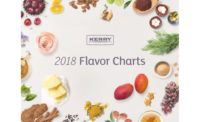Tastes that offer novelty, over-the-top indulgence, and targeted health benefits are set to drive consumer preferences in the U.S. in 2022, according to Kerry.
Trends that were accelerated by the COVID-19 pandemic have developed further and will become more sophisticated in 2022, with consumers seeking new tastes paired with familiar formats and flavors. This will lead to interesting combinations, such as beer blended with kombucha and sage, and chocolate milkshakes with lavender and chilies.
The insights, contained in Kerry’s Global Taste Charts for 2022, reveal the flavors and ingredients that are set to inspire food and beverage innovators across North America, Europe, Latin America, the Asia-Pacific region, the Middle East and Africa over the coming year. Kerry leverages a blend of sources to create these charts and provide in-depth analysis of taste trends, from scanning product launch activity through restaurant/café menu penetration and research reports. This is in addition to Kerry’s proprietary internal insights engines—Trendspotter, for example—that peer into social media influencer content.
Taste trends for 2022
A desire for authentic flavors is being driven by an interest in long-term wellness and overall health following the pandemic, while cravings for more novel flavors—such as Nashville Hot, “everything bagel” seasoning and chili crisp—are being led by consumers seeking surprise and fun from their foods and beverages. Restrictions around movement have also led consumers to “travel the world” through their tastebuds, with Furikake and Sambal trending in meals and entrées. Furikake alone has grown by 103 perecent on restaurant menus versus four years ago (as reported by Datassential Menu Trends 2021).
Indulgence and comfort are also important to consumers and can be invoked through traditional flavors such as chocolate and other sweet temptations. As consumers enthusiastically begin to return to foodservice chains forced to close during the pandemic, tastes such as tahini, alcohol and cocktail-inspired (whiskey, Kahlua), and saffron are emerging across the sweet food and treat spectrum. Tahini alone has grown by 15.3 percent on restaurant menus versus four years ago (Datassential Menu Trends 2021).
Meanwhile, with an increasing focus on gut health, immune support and emotional well-being, consumers are looking for better-for-you food and beverages that make them feel they’re taking an active role in their own future health. As always, taste is leading the way, with turmeric—the quintessential superfood ingredient—seeing a 129 percent increase in use on restaurant menus versus four years ago (Datassential Menu Trends 2021).
Commenting on taste trends, Soumya Nair, global consumer research and insights director at Kerry, said: “The COVID-19 pandemic has affected consumers on a deeply emotional level, changing consumers’ priorities and perceptions about health and wellness. This has certainly impacted their overall food and beverage preferences, challenging innovators to create new tastes that surprise and delight consumers and drive new product development and innovation successes.”
“Emerging flavors and ingredients paint a picture of the proactive consumer, looking for functionally-forward food and beverages that help them achieve their overall health and wellness goals. Additionally, in the current travel-deprived marketplace, people want to travel through their tastebuds—with authentic original Asian and Indian flavors set to make a bold comeback in emerging foods and drinks. While consumers turn to familiar favorites, this year we will see an increased hunger for new experiences and thrilling new flavors. We will see consumers seeking an element of surprise from traditional formats, as well as comfort. Brands can appeal to this desire for novelty by pairing emerging and up-and-coming flavors with old classics.”
Sustainable nutrition
Sustainability is another important driver, with consumers now seeking ingredients that are responsibly sourced and back by provenance. Recent research by Kerry has found, globally, that 49 percent of consumers now consider sustainability when purchasing food and beverage products.
“Consumers are also actively seeking out sustainable food and beverage products that have a significantly positive impact on the planet as well as on their personal health and wellbeing, looking for products with consumer-friendly ingredients, clean label claims and locally and ethically sourced ingredients. In the charts, we see this demand through ingredients such as botanicals and spices ethically sourced from their country of origin (such as cloves, cardamom, tamarind, black pepper, lavender, etc.). We summarize this psychological behavior shift as ‘Provenance with a conscience.’ This all contributes to the flavor trends we see today and will see tomorrow, which point towards purposeful and authentic taste experiences,” Nair adds.
Start your taste story today
In a dynamic and fast-changing environment, innovation has never been so important to meet consumer preferences. Taste is the place to begin the journey.
“Taste is the foundation of innovation and successful new product development that captures consumer attention. Kerry aims to go further, together with our customers, making inspiration actionable and helping to create products that will stand out in the marketplace. If you want to build taste into the story of your brand, we can help you go further,” Nair concluded.
Kerry’s U.S. Taste Charts report is available for download here.



